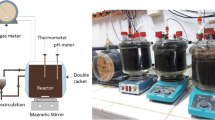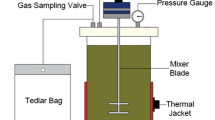Abstract
In this work, the process performance of three parallel anaerobic digesters was evaluated while treating emulsified long-chain fatty acids (LCFA) (i.e., palmitic, stearic and oleic acid) at two different organic loading rates (OLR) (2 and 4 g L−1 day−1). The digester treating palmitic acid achieved a biogas yield of 0.42 ± 0.05 L g−1 COD with a digester effluent COD of 2.3 ± 0.4 g L−1 and VFA concentrations below 250 mg L−1. Stearic acid showed lower biogas yield values (0.34 ± 0.05 L g−1 COD) with low effluent COD (2.5 ± 0.4 g L−1) and VFA concentrations (< 350 mg L−1). On the contrary, anaerobic digestion of oleic acid was accompanied with increased effluent COD (4.5 ± 0.7 g L−1) and VFA concentrations (2.7 ± 1.5 g L−1). As such, COD removal efficiency remained at 89 ± 1% compared to 95 ± 1% for the digesters treating palmitic and stearic acid. During continuous digester operation, there was a decrease in VFA concentrations (around 1–2 g L−1), combined with increasing biogas yield values up to 0.51 ± 0.04 L g−1 COD, possibly due to biomass adaptation to oleic acid. Digester foaming was recorded when the accumulated COD was higher than 200, 1200 and 500 mg COD g−1 MLSS for the digester treating palmitic, stearic and oleic acid, respectively. ADM1 simulation allowed for the determination of the maximum specific LCFA consumption rate constant (km) which was equal to 4.8, 1.6 and 8.0 day−1 for palmitic, stearic and oleic acid respectively.





Similar content being viewed by others
References
Souza DZ, Smidt H, Alves MM, Stams AJM (2009) Ecophysiology of syntrophic communities that degrade saturated and unsaturated long-chain fatty acids. FEMS Microbiol Ecol 68:257–272
Reis P, Holmberg K, Watzke H, Leser ME, Miller R (2009) Lipases at interfaces: a review. Adv Colloid Interface 147–148:237–250
Sam-Soon PALNS, Loewenthal RE, Wentzel MC, GvR M (1991) A long-chain fatty acid, oleate, as sole substrate in upflow anaerobic sludge bed (UASB) reactor systems. Water SA 17:31–36
Madigan MT, Martinko JM, Stahl DA, Clark DP (2012) Brock: biology of microorganisms, 13th edn. Pearson Education Inc, USA
Lalman JA, Bagley DM (2001) Anaerobic degradation and methanogenic inhibitory effects of oleic and stearic acids. Water Res 35:2975–2983
Alves MM, Viera JAM, Pereira RMA, Pereira M, Mota M (2001) Effect of lipids and oleic acid on biomass development in anaerobic fixed-bed reactors. Part I: biofilm growth and activity. Water Res 35:255–263
Shin HS, Kim SH, Lee CY, Nam SY (2003) Inhibitory effects of long-chain fatty acids on VFA degradation and β-oxidation. Water Sci Technol 47(10):139–146
Souza DZ, Salvador AF, Ramos J, Guedes AP, Barbosa S, Stams AJM, Alves MM, Pereira MA (2013) Activity and viability of methanogens in anaerobic digestion of unsaturated and saturated long-chain fatty acids. Appl Environ Microbiol 79:4239–4245
Wu LJ, Kobayashi T, Li YY, Xu KQ, Lv Y (2017) Determination and abatement of methanogenic inhibition from oleic and palmitic acids. Int Biodeter Biodegrad 123:10–16
Zonta Ž, Alves MM, Flotats X, Palatsi J (2013) Modelling inhibitory effects of long chain fatty acids in the anaerobic digestion process. Water Res 47:1369–1380
Palatsi J, Illa J, Prenafeta-Boldu FX, Laureni M, Fernandez B, Angelidaki I, Flotats X (2010) Long-chain fatty acids inhibition and adaptation process in anaerobic thermophilic digestion: batch tests, microbial community structure and mathematical modelling. Bioresour Technol 101:2243–2251
Baserba MG, Angelidaki I, Karakashev D (2012) Effect of continuous oleate addition on microbial communities involved in anaerobic digestion process. Bioresour Technol 106:74–81
Regueiro L, Carballa M, Lema JM (2016) Microbiome response to controlled shifts in ammonium and LCFA levels in co-digestion systems. J Biotechnol 220:35–44
Noutsopoulos C, Mamais D, Antoniou K, Avramides C (2012) Increase of biogas production through co-digestion of lipids and sewage sludge. Global NEST J 14:133–140
Eftaxias A, Diamantis V, Aivasidis A (2018) Anaerobic digestion of thermal pre-treated emulsified slaughterhouse wastes (TESW): effect of trace element limitation on process efficiency and sludge metabolic properties. Waste Manag 76:357–363
Eftaxias A, Gkalimanis P, Koskinari MD, Koumara A, Diamantis V, Aivasidis A (2019) Use of diluted poultry manure as a low-cost emulsifier for anaerobic digestion of used cooking oil. Water Pract Technol 14:937–945
Salama ES, Saha S, Kurade MB, Dev S, Chang SW, Jeon BH (2018) Recent trends in anaerobic co-digestion: Fat, oil, and grease (FOG) for enhanced biomethanation. Prog Energy Combust 70:22–42
Hebishy E, Zamora A, Buffa M, Blasco-Moreno A, Trujillo AJ (2017) Characterization of whey protein oil-in-water emulsions with different oil concentrations stabilized by ultra-high pressure homogenization. Processes 5:6
Eftaxias A, Diamantis V, Michailidis C, Stamateatou K, Aivasidis A (2020) The role of emulsification as pre-treatment on the anaerobic digestion of oleic acid: process performance, modeling and sludge metabolic properties. Biomass Convers Bior. https://doi.org/10.1007/s13399-019-00600-4
Astals S, Batstone DJ, Mata-Alvarez J, Jensen PD (2014) Identification of synergistic impacts during anaerobic co-digestion of organic wastes. Bioresour Technol 169:421–427
Spyridonidis A, Skamagkis Th, Lambropoulos L, Stamatelatou K (2018) Modeling of anaerobic digestion of slaughterhouse wastes after thermal treatment using ADM1. J Environ Manag 224:49–57
Pereira MA, Pires OC, Mota M, Alves MM (2005) Anaerobic biodegradation of oleic and palmitic acids: evidence of mass transfer limitations caused by long chain fatty acid accumulation onto the anaerobic sludge. Biotechnol Bioeng 92:15–23
Cavaleiro AJ, Salvador AF, Alves JI, Alves M (2009) Continuous high rate anaerobic treatment of oleic acid based wastewater is possible after a step feeding start-up. Environ Sci Technol 43:2931–2936
Batstone DJ, Keller J, Angelida I, Kalyuzhnyi SV, Pavlostathis SG, Rozzi A, Sanders W, Siegrist H, Vavilin VA (2002) The IWA anaerobic digestion model no 1 (ADM1). Water Sci Technol 45(10):65–73
American Public Health Association (APHA) American Water Works Association and Water Environment Federation (1998) Standard methods for the examination of water and wastewater. American Public Health Association, Washington, DC
Diamantis V, Melidis P, Aivasidis A (2006) Continuous determination of volatile products in anaerobic fermenters by on-line capillary gas chromatography. Anal Chim Acta 573–574:189–195
Hwu CS, van Lier JB, Lettinga G (1998) Physicochemical and biological performance of expanded granular sludge bed reactors treating long-chain fatty acids. Process Biochem 33:75–81
Bober K, Garus M (2006) RP-HPTLC application in the investigation of solubility in water of long-chain fatty acids. J Liq Chromatogr Relat Technol 29:2787–2794
Yalkowky SH, He Y, Jain P (2010) Handbook of aqueous solubility data. CRC Press, USA
Alves MM, Pereira MA, Sousa DZ, Cavaleiro AJ, Picavet M, Smidt H, Stams AJ (2009) Waste lipids to energy: how to optimize methane production from long-chain fatty acids (LCFA). Microb Biotechnol 2(5):538–550
Palatsi J, Affes R, Fernandez B, Pereira MA, Alves MM, Flotats X (2012) Influence of absorption and anaerobic granular sludge characteristics on long chain fatty acids inhibition process. Water Res 46:5268–5278
Cavaleiro AJ, Pereira MA, Guedes AP, Stams AJM, Alves MM, Souza DZ (2016) Conversion of Cn-unsaturated into Cn-2-saturated LCFA can occur uncoupled from methanogenesis in anaerobic bioreactors. Environ Sci Technol 50:3082–3090
Cavaleiro AJ, Pereira MA, Alves M (2008) Enhancement of methane production from long-chain fatty acid based effluents. Bioresour Technol 99:4086–4095
Goncalves MR, Costa JC, Marques IP, Alves MM (2011) Inoculum acclimation to oleate promotes the conversion of olive mill wastewater to methane. Energy 36:2138–2141
Ribeiro NJ, Pires OC, Mota M, Ferreira EC, Alves MM (2001) influent of up-flow velocity on the performance of an anaerobic filter under oleic acid overloads. Biotechnol Lett 23:1833–1839
Amaral AL, Pereira MA, da Motta M, Pons MN, Mota M, Ferreira EC, Alves MM (2004) Development of image analysis techniques as a tool to detect and quantify morphological changes in anaerobic sludge: II. Application to a granule deterioration process triggered by contact with oleic acid. Biotechnol Bioeng 87:194–199
Jeganathan J, Nakhla G, Bassi A (2006) Long-term performance of high-rate anaerobic reactors for the treatment of oily wastewater. Environ Sci Technol 40:6466–6472
Moriasi D, Arnold J, Van Liew M, Bingner R, Harmel RD, Veith T (2007) Model evaluation guidelines for systematic quantification of accuracy in watershed simulations. Trans ASABE 50(3):885–900
Acknowledgements
The research was supported by the General Secretariat for Research and Technology (GSRT) and the Hellenic Foundation for Research and Innovation (HFRI).
Author information
Authors and Affiliations
Corresponding author
Ethics declarations
Conflict of interest
The authors declare that they have no conflict of interest.
Ethical approval
This article does not contain any studies with human participants or animals performed by any of the authors.
Additional information
Publisher's Note
Springer Nature remains neutral with regard to jurisdictional claims in published maps and institutional affiliations.
Rights and permissions
About this article
Cite this article
Eftaxias, A., Diamantis, V., Michailidis, C. et al. Comparison of anaerobic digesters performance treating palmitic, stearic and oleic acid: determination of the LCFA kinetic constants using ADM1. Bioprocess Biosyst Eng 43, 1329–1338 (2020). https://doi.org/10.1007/s00449-020-02328-2
Received:
Accepted:
Published:
Issue Date:
DOI: https://doi.org/10.1007/s00449-020-02328-2




